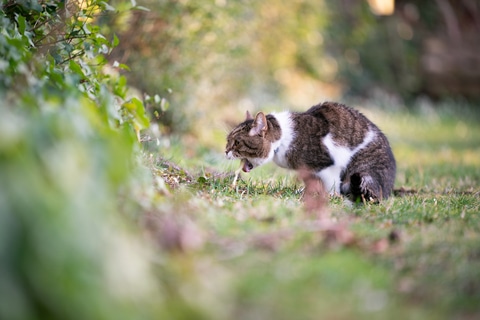Everything, Cats, Health care, Pet Care
Cats and Hairballs
Fluffy looks healthy and content as she does her normal cat things. Suddenly – and possibly on your carpet – she begins to retch. When she’s finished, she resumes her normal cat routine.
Is your cat sick? Perhaps, but a likely cause is hairballs. Hairballs are common in cats, particularly long-haired cats. With our help, though, they don’t have to be common.
Why do cats cough up hairballs?
When cats groom themselves, their rough tongues remove loose hair from their coats. Cats then ingest the hair, and it passes through their digestive system. That is, it usually does. Other times, or with other cats, the hair clumps together in the cat’s stomach and irritates it, causing the cat to gag and heave while trying to bring up the hairball.
Your cat might bring up food or a wad of hair, or she might just bring up fluid. Up to four times a month can be normal for cats.
If your cat does not pass the hairball, either through vomiting or in her stools, it can block the intestinal tract. Your cat may be less interested in food, lose weight, or be constipated. Surgery may be necessary in these cases.
Reducing hairballs in cats
Hairball prevention and treatment in cats falls in four categories, which include commercial and home remedies.
Cat grooming
The more loose hair you remove from your cat’s coat with daily grooming, the less hair your cat will ingest. Prevention is the first step, and grooming your cat is the most effective way to prevent or reduce hairballs.
For information on how to groom your cat, see the Odor Destroyer article How to Groom Your Cat.
Additional fiber
Extra fiber in your cat’s diet can help carry hair out of the body. Catnip and grass (wheat, oats, rye, barley), are good sources of fiber, as is canned pumpkin, oat bran, green beans, flax seed, and psyllium husks. The additional fiber can be given to your cat every second day, mixed in with regular food if necessary. Half a teaspoon to a teaspoon of canned pumpkin or one-quarter teaspoon of flax seed or psyllium is usually enough.
Psyllium also comes in chewable or capsule supplements to treat hairballs.
Lubricants
Various commercial lubricants are available to make it easier for your cat to pass hair. Your cat may like the taste of the lubricant and lick it off your finger, or you can put it on her nose or paws and she’ll lick it off to clean herself. Some lubricants are in the middle of cat treats.
Each commercial lubricant will have its own dosing schedule. If you give your cat too much, she may have soft stools.
In addition, petroleum jelly lubricates hair in the cat’s stomach so that it will pass more easily. Apply a quarter teaspoon on your cat’s paws once a day for about four days when your cat appears to be trying to bring up hairballs.
Special diets
Some commercial cat foods are higher in fiber to help reduce hairballs.
When a hairball is more than a hairball
Vomiting may be a sign of another problem, particularly if your cat doesn’t bring up hairballs or if she vomits more than about once a week. If your cat vomits more often, or if the treatments listed here don’t alleviate the problem, take her to her veterinarian. Other reasons for vomiting include infections, food sensitivities, and inflammatory bowel disease. Don’t wait too long before consulting with your veterinarian when your cat is vomiting.


